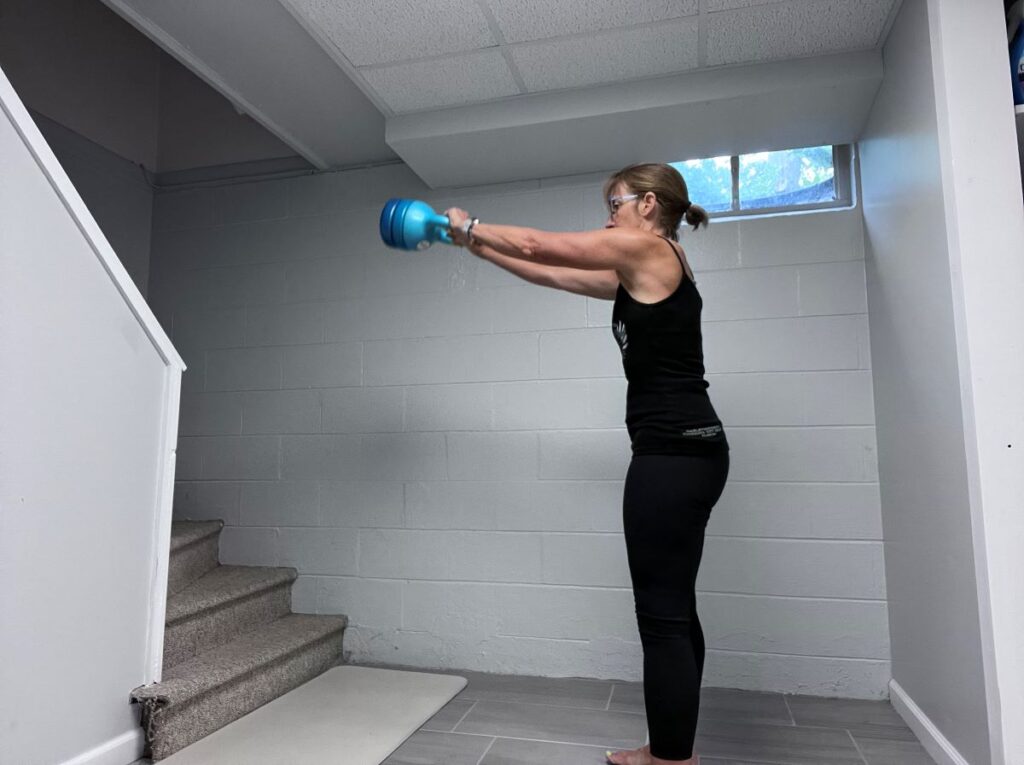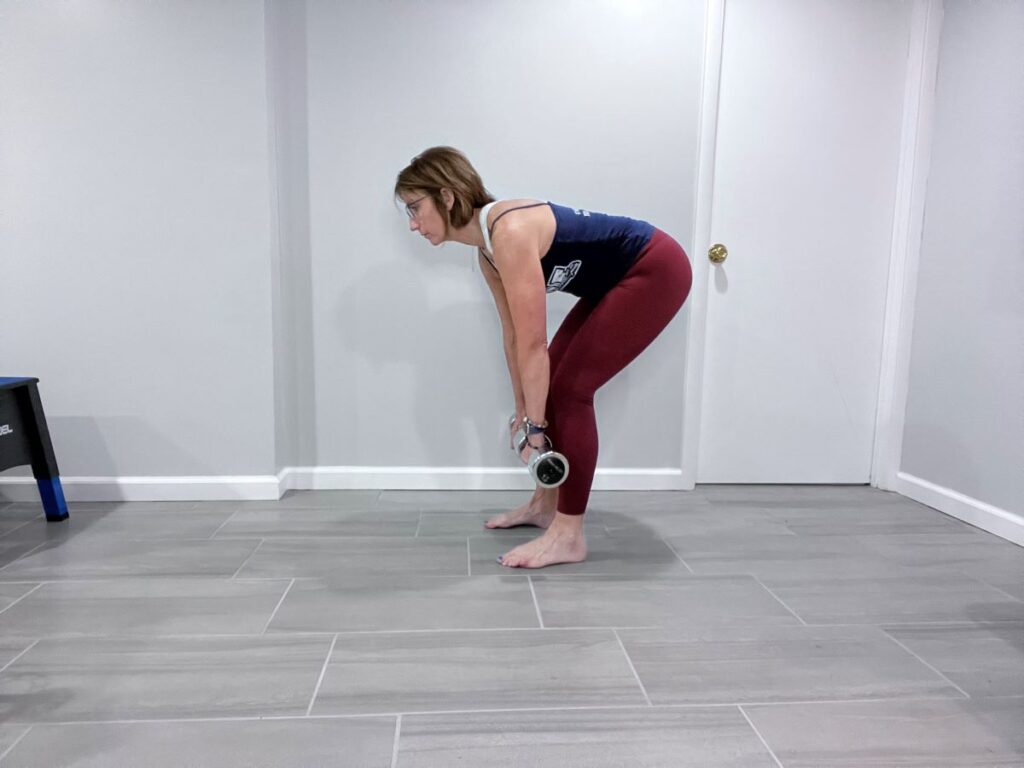Best Alternatives to Step Ups: Simple Exercises for Older Adults
As someone who enjoys working out at home, I am always looking for new exercises that are fun, effective, and challenging – but also safe as I age.
Now, that doesn’t mean that I am ready to settle for sit-down “old lady” exercises!
Like you, I still want a heart-pumping, body-moving workout that keeps me strong.
After my knee replacement, I had to focus on my lower-body strength so that I could get back to my normal routine.
One exercise that is great for lower body strengthening is step-ups.
They are a compound exercise that works the glutes, quads, and hamstrings.
But step-ups can be a challenge for some, especially if we’re dealing with knee pain, limited hip mobility, or recovering from lower body surgery.
However, the good news – there are plenty of low-impact exercises that you can do instead of step-ups.
In this blog post, I’ll share some awesome alternatives to step-ups that you can easily do in the comfort of your own home.
This post may contain affiliate links. As an Amazon Associate, I earn from qualifying purchases. This means I may earn a commission at no extra cost to you should you choose to make a purchase using my link.
Benefits of Step-Ups
Step-ups have such a huge range of benefits, which is why I love them.
They’re a compound exercise, which means they work multiple muscle groups and joints with each rep.
So you get more bang for your buck!
Step-ups target your quads, glutes (aka your booty), and hamstring muscles, so they help to improve your lower body strength.
This is key for better balance and stability.
That means you’ll be able to conquer everyday activities like climbing stairs, standing up, and sitting without moaning or grunting!
Now, I know step-ups can be a bit challenging for some of us.
But don’t worry!
There are plenty of alternative exercises you can do with or without fancy equipment.
So, no excuses, my friend – let’s get moving!
Bodyweight Exercise Alternatives to Step Ups
Overall, bodyweight exercises are a great way to build strength and improve your fitness without any equipment.
If you don’t have weights or resistance bands, it’s not a problem. You can still get a great workout for your quads, hamstrings, glutes, and calves.
Here are some of the best alternative exercises for step-ups that can be done with or without weights.
Squats
A bodyweight squat is a great lower-body exercise that targets your quads, hamstrings, and glutes.
This makes them a great alternative to step-ups!
To perform a squat:
- Stand with your feet shoulder-width apart.
- Keep your chest up
- Lower your hips down towards the ground as if you are sitting on a chair.
- Make sure to keep your knees in line with your toes.
- Push through your heels to come back up.
READ MORE: 7 Easy Squats For Aging Knees: Tips And Techniques | Simply Aging Healthy
You can make squats more challenging by holding free weights, kettlebells, resistance bands, or medicine balls.


Lunges
Lunges are another excellent bodyweight exercise that targets your quads, hamstrings, and glutes.
To perform a regular lunge:
- Step forward with one foot, keeping your knee directly above your ankle.
- Lower your back knee towards the ground.
- Push through your front heel to come back up and repeat on the other side.
If you find a forward lunge to be difficult, you can do a reverse lunge instead.
This is when you take your leg behind you instead of out front and then return to the starting position.
You can also make lunges more challenging by doing walking lunges.
READ MORE: Best Modified Lunges For Seniors: Easy Exercises To Stay Active | Simply Aging Healthy
Again, adding weights is also a good way to up your game.
Glute Bridges
Glute bridges are a great exercise to target your glutes and hamstrings.
To perform a glute bridge:
- Lie on your back with your knees bent.
- Place your feet flat on the ground.
- Push through your heels.
- Lift your hips up towards the ceiling, squeezing your glutes at the top.
- Lower your hips back down and repeat.
You can make glute bridges more challenging by holding a weight or doing single-leg bridges.
Wall Sits
Wall sits are a challenging exercise that targets your quads and glutes.
To perform a wall sit:
- Stand with your back flat against a wall.
- Lower your hips down until your thighs are parallel to the ground.
- Hold this position for as long as you can.
- Keep your back flat against the wall while squatting.
You can make wall sits more challenging by holding weights or by doing a single-leg by alternating your feet up and down in a marching fashion.


Heel Elevated Squats
Heel elevated squats are an excellent exercise to work the quads and glutes.
They are basically squats done with heels on an elevated platform, such as weight plates, yoga blocks, or some books.
To do heel-raised squats:
- Place a raised platform behind each foot.
- Stand with your feet hip-width apart.
- Keep your chest up
- Lower your hips down towards the ground as if you are sitting on a chair.
- Make sure to keep your knees in line with your toes.
- Push through your heels to come back up.


Bulgarian Split Squats
Bulgarian split squats are a great exercise for building strength and stability in your legs.
Like step-ups, Bulgarian split squats are one of the best unilateral exercises.
To perform this exercise:
- Stand with your back foot on an elevated surface such as a bench, couch or chair.
- Lower your body down until your front thigh is parallel to the ground.
- Push back up to the starting position.
- Then, switch sides and repeat on the other leg.
To make this exercise more challenging, hold a weight in one or both hands.


Stair Climbing
If you have a set of stairs in your home, why not use them?
Simply walk up and down the stairs for a set amount of time or a certain number of repetitions.
To make the workout more challenging, you can also try skipping steps or taking the stairs two at a time.
Weighted or Resistance Band Exercises
Using free weights or resistance bands is definitely beneficial if you want to up your workout game!
Here are some weighted/resistance band exercises that can replace step-ups:
Good Mornings
This exercise seems very simple, but it does pack a punch on the posterior chain which includes glutes and hamstrings!
You can do these with or without weights or with a resistance band– it’s your call!
To do Good Mornings:
- Stand with your feet shoulder-width apart.
- Place a weight or barbell on the back of your neck – use caution.
- Keep your back straight to avoid lower back pain.
- Bend at the hips with knees slightly bent.
- Lower your torso forward until you are parallel to the ground.
- Engage your core and glutes as you return to the starting position, keeping your back straight and avoid rounding the spine.
- Repeat 10-12 times.


Kettle Bell Swings
Kettlebell swings work your entire body but mostly the posterior chain, including the glutes, hamstrings, spinal erectors, and muscles of the upper back.
They are also high-intensity, low-impact exercises.
This makes them one of the best exercises to include in your workout routine.
To perform kettlebell swings:
- Stand with feet shoulder-width apart.
- Place the kettlebell or weight in both hands between your legs.
- With a straight back and engaged core, swing the kettlebell or weight back between your legs.
- Quickly reverse direction and drive your hips forward with explosive power to propel the weight up to chest level.
- Then, bring the kettlebell or weight back between your legs.
- Repeat 10-12 times.


Romanian Deadlifts
To do a Romanian deadlift:
- Stand with feet shoulder-width apart.
- Hold the weights or a barbell in/with both hands.
- Bend forward at the hips with knees slightly bent.
- Keep your back straight, chest up, and engage your core.
- Return to standing position as you tighten your glutes.
- Repeat 10-15 times.


You can also target one leg at a time instead of both. Just place your right foot behind your left foot or lift the back leg behind you as you lean forward.
Be sure to use proper form.
Avoid starting with heavy weights. This could mess with your form. Start with a lightweight until you get the form down.


Kettlebell Goblet Squats
To do goblet squats:
- Stand with feet shoulder-width apart
- Hold a kettlebell close to your chest with both hands. If you don’t have a kettlebell, a free weight works, too.
- Engage your core and keep your chest up.
- Push your hips back as you bend at the knees, lowering your body.
- Lower as low as you can tolerate. Try to get parallel to the ground.
- Push through your heels to return to standing.
- Repeat exercise 10-15 times.
Including weighted or resistance band exercises in your home workouts can be a fun and effective way to build strength and endurance.
As you get stronger, don’t be afraid to try heavier weights.


Yoga and Pilates Moves
If you’re not a fan of weighted exercises, yoga and Pilates moves might be a good alternative.
They are also compound exercises that work for more than two muscle groups.
You’ll be surprised how much they can work your entire lower body.
Here are a few of my favorite moves.
Warrior Pose
One of my favorite yoga poses for strengthening the legs is the Warrior Pose.
To do this pose:
- Start in a standing position with your feet hip-width apart.
- Step your left foot back and turn it out to a 45-degree angle.
- Bend your right knee and sink down into a lunge position.
- Keep your knee directly over your ankle.
- Raise your arms overhead and hold for several breaths.
- Repeat on the other side.

Chair Pose
Another great yoga pose for working the legs is the Chair Pose.
- Begin in a standing position with your feet together.
- Inhale and raise your arms overhead.
- As you exhale, bend your knees and lower your hips as if you were sitting in an imaginary chair.
- Keep your knees over your ankles and your weight in your heels.
- Hold for several breaths, then release.

Pilates Leg Pulls
In Pilates, Leg Pulls are a challenging exercise that work the legs and core muscles.
- Start in a plank position with your hands under your shoulders.
- Place your feet together.
- Lift your right leg off the ground and extend it behind you.
- Keep your hips level.
- Lower your leg back down.
- Alternate legs

Warm-Up, Cool Down and Stretching
Before and after any workout routine, be sure to include a 10-15 minute warm-up and cool-down.
Don’t skip out on this!
This gives your muscles time to get fired up before your workout and cool down after a workout, which will improve your flexibility over time.
Conclusion
It’s important to listen to your body and choose exercises that are appropriate for your fitness level.
These simple exercises are great alternatives to step-ups, providing similar benefits without the added stress to your joints.
Including these lower-body strength exercises in your workout routine will help you maintain or improve muscle growth and strength, mobility, and independence as you age.
Always consult your doctor before starting any new exercise program.
Keep moving, and never give up on your fitness goals!
